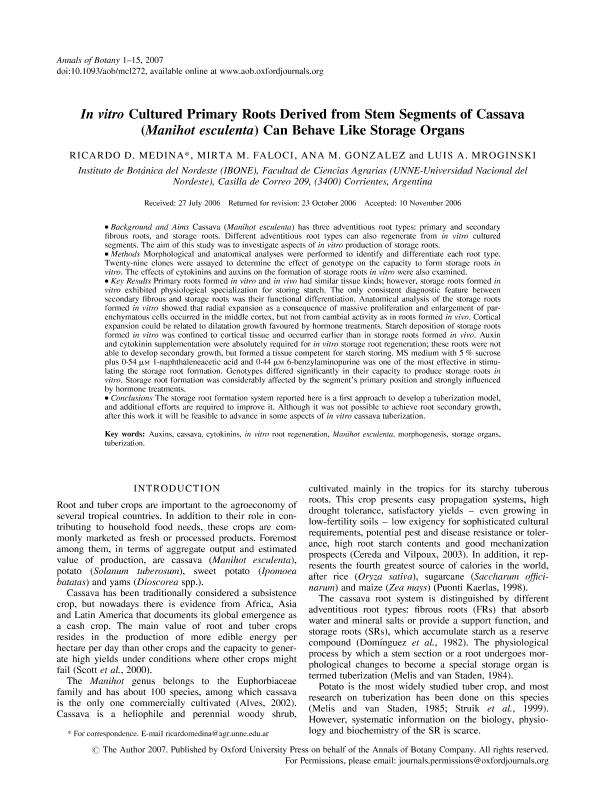Artículo
In vitro cultured primary roots derived from stem segments of cassava (Manihot esculenta) can behave like storage organs
Fecha de publicación:
03/2007
Editorial:
Oxford University Press
Revista:
Annals of Botany
ISSN:
0305-7364
e-ISSN:
1095-8290
Idioma:
Inglés
Tipo de recurso:
Artículo publicado
Clasificación temática:
Resumen
Background and Aims. Cassava (Manihot esculenta) has three adventitious root types: primary and secondary fibrous roots, and storage roots. Different adventitious root types can also regenerate from in vitro cultured segments. The aim of this study was to investigate aspects of in vitro production of storage roots. Methods. Morphological and anatomical analyses were performed to identify and differentiate each root type. Twenty-nine clones were assayed to determine the effect of genotype on the capacity to form storage roots in vitro. The effects of cytokinins and auxins on the formation of storage roots in vitro were also examined. Key Results Primary roots formed in vitro and in vivo had similar tissue kinds; however, storage roots formed in vitro exhibited physiological specialization for storing starch. The only consistent diagnostic feature between secondary fibrous and storage roots was their functional differentiation. Anatomical analysis of the storage roots formed in vitro showed that radial expansion as a consequence of massive proliferation and enlargement of parenchymatous cells occurred in the middle cortex, but not from cambial activity as in roots formed in vivo. Cortical expansion could be related to dilatation growth favoured by hormone treatments. Starch deposition of storage roots formed in vitro was confined to cortical tissue and occurred earlier than in storage roots formed in vivo. Auxin and cytokinin supplementation were absolutely required for in vitro storage root regeneration; these roots were not able to develop secondary growth, but formed a tissue competent for starch storing. MS medium with 5% sucrose plus 0.54 mM 1-naphthaleneacetic acid and 0.44 mM 6-benzylaminopurine was one of the most effective in stimulating the storage root formation. Genotypes differed significantly in their capacity to produce storage roots in vitro. Storage root formation was considerably affected by the segment’s primary position and strongly influenced by hormone treatments. The storage root formation system reported here is a first approach to develop a tuberization model, and additional efforts are required to improve it. Although it was not possible to achieve root secondary growth, after this work it will be feasible to advance in some aspects of in vitro cassava tuberization.
Archivos asociados
Licencia
Identificadores
Colecciones
Articulos(CCT - NORDESTE)
Articulos de CTRO.CIENTIFICO TECNOL.CONICET - NORDESTE
Articulos de CTRO.CIENTIFICO TECNOL.CONICET - NORDESTE
Articulos(IBONE)
Articulos de INST.DE BOTANICA DEL NORDESTE (I)
Articulos de INST.DE BOTANICA DEL NORDESTE (I)
Citación
Medina, Ricardo Daniel; Faloci, Mirta Mabel; González, Ana María; Mroginski, Luis Amado; In vitro cultured primary roots derived from stem segments of cassava (Manihot esculenta) can behave like storage organs; Oxford University Press; Annals of Botany; 99; 3; 3-2007; 409-423
Compartir
Altmétricas




